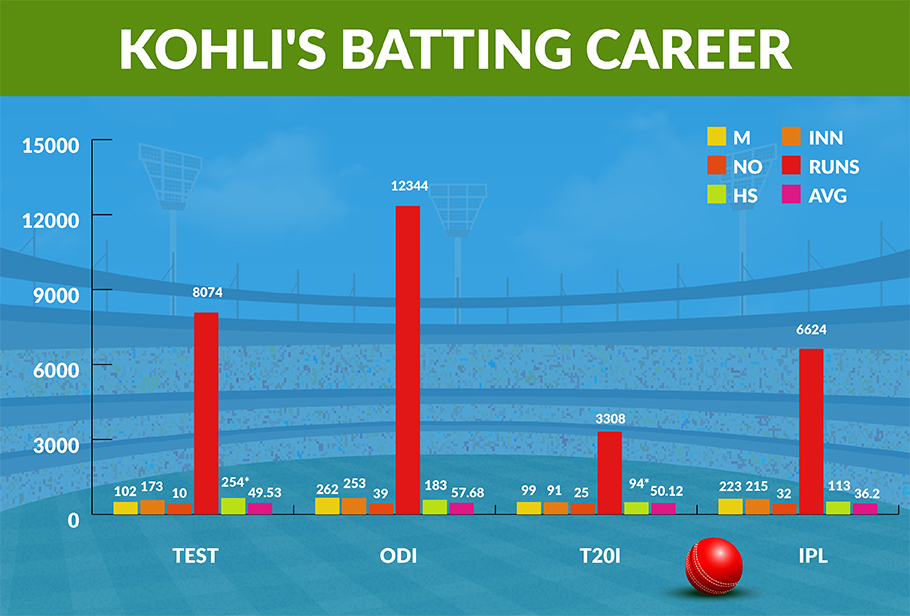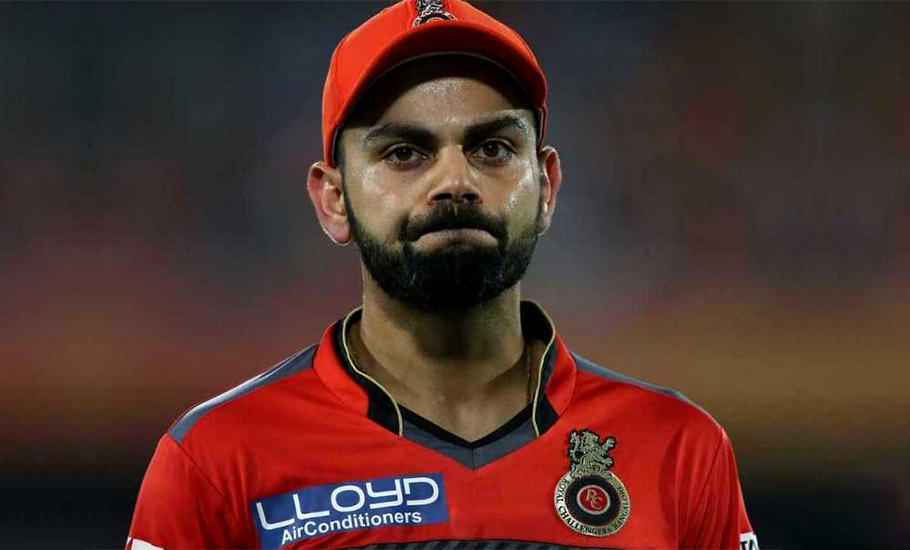
- Home
- News
- Analysis
- States
- Perspective
- Videos
- Education
- Entertainment
- Elections
- World Cup 2023
- Features
- Health
- Business
- Series
- Economy Series
- Earth Day
- Kashmir’s Frozen Turbulence
- India@75
- The legend of Ramjanmabhoomi
- Liberalisation@30
- How to tame a dragon
- Celebrating biodiversity
- Farm Matters
- 50 days of solitude
- Bringing Migrants Home
- Budget 2020
- Jharkhand Votes
- The Federal Investigates
- The Federal Impact
- Vanishing Sand
- Gandhi @ 150
- Andhra Today
- Field report
- Operation Gulmarg
- Pandemic @1 Mn in India
- The Federal Year-End
- The Zero Year
- Premium
- Science
- Brand studio
- Home
- NewsNews
- Analysis
- StatesStates
- PerspectivePerspective
- VideosVideos
- Entertainment
- ElectionsElections
- Sports
- Loading...
Sports - Features
- BusinessBusiness
- Premium
- Loading...
Premium

What on earth happened to Virat Kohli?

Virat Kohli averages 49.53 from 102 Tests, 57.68 in 262 One-Day Internationals and 50.12 in 99 Twenty20 Internationals. Now, these are numbers 99% of cricketers, at the very least, around the world would give an arm and a leg for. So, if one is now even contemplating questioning his credentials, does that mean he is a victim of his own lofty standards? Let’s take a pause and consider this....
Virat Kohli averages 49.53 from 102 Tests, 57.68 in 262 One-Day Internationals and 50.12 in 99 Twenty20 Internationals. Now, these are numbers 99% of cricketers, at the very least, around the world would give an arm and a leg for. So, if one is now even contemplating questioning his credentials, does that mean he is a victim of his own lofty standards?
Let’s take a pause and consider this. That he doesn’t have an international century for 2.5 years and nearly 80 innings across formats is well documented. Cricket is essentially a numbers game and for a batsman of Kohli’s calibre to not touch three-figures for this long is a genuine concern, especially because he hasn’t looked like getting there for quite a while now. As staggering as his overall statistics might be, are Kohli’s reputation and past performances bailing him out despite a sustained run of poor form?

There is no easy answer to either question. After all, Kohli is not your ordinary journeyman batsman. Until hitting this extended trough, he rode the crest of a wave for all of five years, striding the cricketing firmament like a colossus as he stacked up runs, centuries and double-hundreds for fun, batting with a fluency and authority seldom witnessed in the history of the game.
It was inevitable that the law of diminishing returns would eventually catch up with arguably the finest batsman of his generation. As the cricketing world dissects his recent tribulations, it won’t be out of place to reflect on what went into making him the most complete and prolific batsman for five long years when fashionable terminologies such as ‘workload management’ and ‘taking a break’ weren’t a part of his lexicon.
Whether in form or desperately searching for runs, the one constant that has characterised Kohli has been his all-out, unflagging, uncompromising intensity. Be it a gentle workout masquerading as a practice game on the eve of an overseas Test, a high-stakes Indian Premier League outing for his beloved Royal Challengers Bangalore, a scrap for supremacy against Australia or a less demanding walk-in-the-park against Namibia, Kohli doesn’t know what it is to not give 100 per cent, ball after ball, minute after accruing minute. Lesser mortals would have been singed by their own fire a long time back. Kohli has established beyond reasonable doubt that with bat in hand or with his electric agility on the park, he can never be mistaken for a lesser mortal.
Where has that raging fire disappeared? How has the incessant downpour of high-quality runs been downgraded to a barely discernible trickle? And why is the man who abhorred the concept of rest unless it was absolutely essential now missing more matches than he is playing for the country?
Since the beginning of 2022, Kohli’s appearances for the country have been reduced to four Tests, as many T20Is and eight ODIs. Very few of them have been particularly fruitful – he has just four half-centuries in all three formats put together in 18 innings, with averages ranging from 20.25 (T20Is) to 21.85 (ODIs) and 31.42 (Tests). Not even Kohli’s staunchest supporter can deny that he is woefully out of runs, form, touch and, let’s face it, confidence.
It’s no secret that when the going is good, the elements conspire to push one’s fortune in the right direction. By the same token, when things go wrong, they do so horribly. Kohli has traversed both ends of the spectrum, and while he has shown outward equanimity in handling the lemons the cricketing gods have hurled at him in recent times, it is impossible that he wouldn’t have been affected by the string of low scores, the attendant scrutiny and the concentration of pressure that he hasn’t been unaccustomed to since being restricted to just 134 runs in 10 Test innings in England in 2014.
Not even the ‘form is temporary, class is permanent’ cliché is something he can seek refuge in any longer, because while there is no disputing his class, the loss of form has been anything but temporary. Typically, he has been dismissed in the most bizarre fashions on occasion in a clear indication that the rub of the green hasn’t gone his way. But more alarmingly from a personal and team standpoint, he has been culpable of being sucked into the same technical indiscretions time after time, especially in the corridor outside off where his bat seems almost magnetically drawn to balls that can comfortably be left alone.
More qualified experts have identified reasons for his sustained susceptibility to the fullish, widish ball leaving him. Most have pointed to a commitment to the front foot irrespective of the length of the ball, and an exaggerated shuffle that takes his left foot well outside the off-stump and therefore suckers him into flirting with balls that don’t require his attention, especially in Test cricket.
It’s not as if head coach Rahul Dravid, batting coach Vikram Rathour, Kohli’s long-time personal coach Raj Kumar Sharma or Kohli himself aren’t unaware of these shortcomings. That the glitches haven’t yet been rectified is what’s particularly surprising, because if there’s one thing Kohli has showcased times without number, it is that he is a constant learner with the gift of extending the gap between failures that helped him lord the batting world for so long.

The Asia Cup in the UAE is less than a month away and that will be the final major preparatory exercise before the T20 World Cup in Australia in October-November. Rohit Sharma’s men are currently in the Caribbean, polishing their skills against inarguably the most dangerous 20-over outfit in the world, and while one would have expected Kohli to be out there doing battle against the West Indians to rediscover runs, form and morale, he is ‘resting’. His own dwindling returns and the emergence of an exciting new crop without a negative bone in their body should mean Kohli can no longer take his place for granted, but how do you score runs when you are not playing?
Perhaps, Kohli felt the need for a complete break from competitive cricket so he could retreat to the relative anonymity of the training ground, rework his technique, recharge himself mentally and return fresh and motivated. But the sands of time are rapidly running out, with no more matches for him before the Asia Cup. What does that mean? Do the selectors and the team management repose faith in his pedigree and hope that his big-match temperament and his love for the big stage will rekindle his romance with run-scoring? Or will they feel the temptation to go with current form hard to resist, especially given that India haven’t won any global silverware since 2013?
This time last year, it would have been unthinkable that Kohli and the decision-makers would be staring at this current predicament. And yet, that’s exactly where we are. Rohit and many other worthies have urged the media, especially, to leave Kohli alone – and we are constantly told that the players don’t read or listen to what’s written or said about them! – but whether that will allow him to return to run-scoring is questionable.
The elephant in the room must be acknowledged and discussed post-haste, if it already hasn’t been done, because Kohli’s mountain of past runs deserves nothing other than sensitivity and empathy. If, as is expected, he continues to enjoy the confidence of those in a position to make decisions, it’s time Kohli started to repay the faith. After all, if he can turn the clock back and slip into his earlier, all-conquering avatar, we all know the magic that will emanate from his bat.

